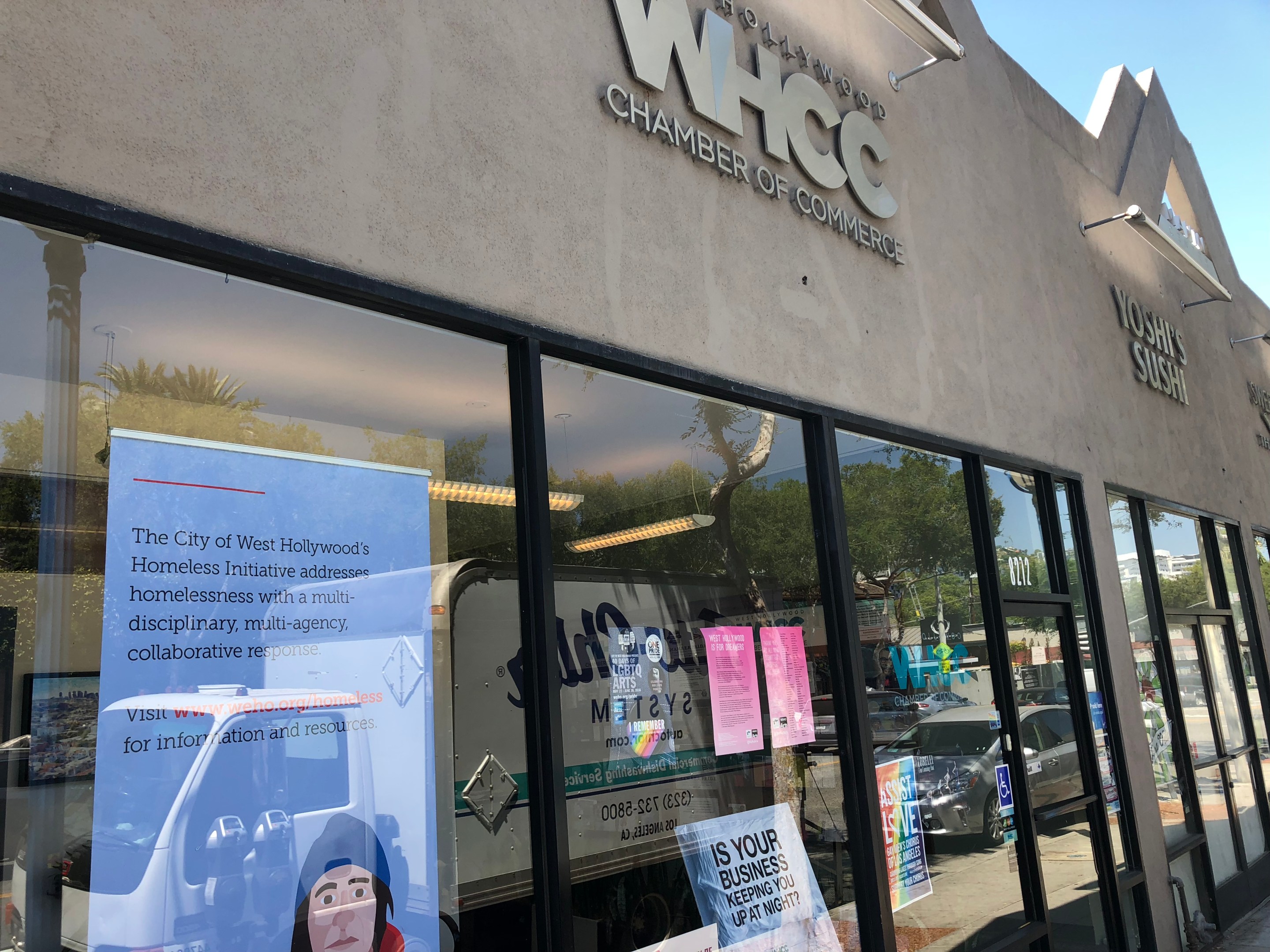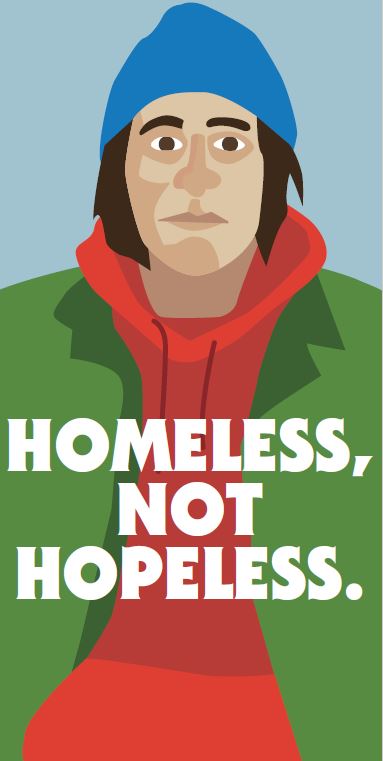Armed with Good Information and Compassion, West Hollywood Makes the Most of Its Community to Battle Homelessness
1:44 PM PDT on August 22, 2018

The West Hollywood Chamber of Commerce’s offices include a message for the city’s homeless that there is help available should they choose it. Photo: Damien Newton
The City of West Hollywood is known for being a unique place in America. Founded in 1984 out of land that was then unincorporated Los Angeles County, West Hollywood was literally built to be a city known for its compassion. It is widely considered one of the most prominent “gay villages” in the United States, and presents itself as a place where people can be themselves even if they’ve been spurned by friends, families, churches, or workplaces somewhere else. While many people associate that compassion as support for people shunned by family and communities because of their sexual identity, it extends to people experiencing homelessness.

This commitment to compassion has led to West Hollywood having more than its share of successes in helping those experiencing homelessness. According to statistics provided by the city, twenty-eight individuals who were formerly homeless in West Hollywood were placed in permanent housing by Ascencia and Step Up on Second over the last year. In the 2018 homeless count, there were 89 people counted living on the streets.
Additionally, the LA LGBT Center’s Youth Center provided 2,158 bed nights to homeless LGBTQ youth, and helped place several of these young adults in transitional, supportive, and other types of housing. 145 residents of West Hollywood received rental assistance from the National Council of Jewish Women (NCJW) or the Alliance for Housing and Healing, enabling them to retain their rental housing.
According to the most recent census, there are roughly 30,000 residents of West Hollywood.
While West Hollywood has not found a magic bullet for “fixing” the problem, the city employs many of the strategies used by cities throughout the region, but with a reputation for doing them well. Corri Planck, the Manager of Strategic Initiatives for the City of West Hollywood, for example, explains that it can take anywhere between 15 and 159 contacts between outreach teams and case workers and someone experiencing homelessness before they are housed. While this number seems high - 159 contacts! - it is actually lower than what occurs in other cities. A recent study in New York shows that attempts to get people experiencing homeless into overnight shelters fail over 99% of the time.
A quick summary of West Hollywood’s outreach strategies can be found on a YouTube video posted by the city earlier this year. The video follows Jake Weinraub, a mental health technician with the LA LGBT Center, throughout his workday. Weinraub believes that positive encounters between people attempting to help those experiencing homelessness and a government agency or social worker does not have to result in a referral to be of value.
“I’ve really had to adjust my idea of what a success is,” Weinraub explains in the video. “Any interaction where someone who is living on the street feels seen for a moment is positive...Sometimes it’s just conversation, a positive interaction - that is enough for that moment.”
Weinraub also discusses what makes West Hollywood a different place requiring different solutions to the regional homeless crisis. For many of the people living on West Hollywood's streets, this life is preferable to a home life where they don't fit in. Weinraub notes the rainbow flags in businesses, the support for people who are still treated as misfits and outcasts in a lot of the rest of the world, as an example of West Hollywood feels like more like home to many people who moved than the places where they are born or where family members still live.
West Hollywood, like many cities, updates and renews its homeless solutions strategies on a regular basis. Earlier this week, the City Council heard a report on the recent Homeless Demographic Survey completed by city staff to provide more, and better, information than what is gathered annually by the county. The data informs many of the decisions made, and sometimes the hyper-local data tells a different story than the data produced by the County. You can read more about the data from the Greater Los Angeles homelessness count here.
In both West Hollywood and the County, there was a large jump in the number of people experiencing homelessness between 2016 and 2017, with a small decrease the following year. But in other ways, the data is different. West Hollywood’s homeless report having HIV-related illness much more frequently than people surveyed throughout the county More than one in six (18.20%) of West Hollywood respondents said that they have HIV-related illness, compared to only 1.6% of respondents in LAHSA’s CoC survey. Significantly higher percentages of people in West Hollywood reported having physical disabilities (29.5% vs. 17%), traumatic brain injuries (11.4% vs. 5.3%), physical illnesses (20.5% vs. 15.2%), post-traumatic stress (20.5% vs. 16.4%), or developmental disabilities (6.8% vs. 5.1%).
The Los Angeles Homeless Services Authority (LAHSA) conducts an annual Homelessness Count each January, enumerating people who are homeless on the street, in shelters, and in tents and vehicles. Around the same time, LAHSA also conducts a demographic survey of homeless people in selected census tracts throughout the county to collect information about the age, length of time homeless, disabling conditions, veteran status, income, employment, and other information that helps to inform service design and planning.
The demographic survey uses a random sampling methodology to select census tracts to be surveyed, and these data are interpreted into a county-wide picture of the characteristics of the population. West Hollywood was one of the first cities to thoroughly survey its homeless residents, using the LAHSA survey starting in 2017 so that its data could be compared to the countywide information. The 2017 survey confirmed much of what West Hollywood leaders suspected: people who are homeless in West Hollywood are more likely to be young, LGBT, survivors of violence and abuse, and HIV-positive.
Armed with this information, West Hollywood can make different plans and offer different services than another similarly sized city.
For example, the Human Rights Campaign released a report in 2012 that focused on best practices for outreach to people who are suffering from both homelessness and HIV/AIDS that has been re-circulated on Social Worker.org. It recommends having staff with in-depth knowledge of the special programs that exist for people experiencing HIV such as Housing Opportunities for Persons Living with AIDS Program (HOPWA) and people prepared to educate clients about the increased health risks (e.g., exposure to infectious diseases) associated with living with HIV/AIDS.
Based on last year’s demographic survey, a case worker specializing in HIV has been added to the homeless outreach teams, to ensure that people who are both HIV-positive and homeless are aware of the programs and options available to help them receive medical care and find temporary shelter or jobs. The City has also added a nurse to the outreach teams, so that medical needs can be addressed.
The benefit of having a specialist in outreach to people infected with HIV cannot be overstated.
“The resources this outreach worker is able to bring to bear [are] different and top-notch. All of our outreach specialists are able to connect people to resources; but his understanding of the systems and agencies and can really get them into the specific systems of care for people infected with HIV,” explains Planck.
Another important member of the city’s outreach team is the Los Angeles County Sheriff’s Department (LASD). For obvious reasons, outreach from the police is something that is not often desired by people experiencing homelessness. In 2016, the story of an on-duty LAPD officer who shot a homeless man who did not appear to be a threat dominated local headlines. More recently, a February, 2018, story in the Los Angeles Times detailed how arrests and tickets for the homeless have skyrocketed in the City of Los Angeles, even though many of the offenses were minor.
Like many smaller cities in Southern California, West Hollywood does not have its own police force and instead contracts with LASD. The sheriff’s deputies at the West Hollywood station include an officer trained and certified in social services who works with the city on outreach.
“They have been doing homeless outreach operations almost monthly. They go out at six in the morning and they bring along members of our outreach teams in an attempt to engage them,” explains Planck. The outreach includes a basic wellness check and an introduction to what resources are available. The deputies and other team members approach people who appear to be homeless with an attitude of friendliness and service.
Another partner is the City’s Chamber of Commerce. While Chambers have a reputation of focusing narrowly on issues related to their members' bottom lines, the West Hollywood Chamber is active in helping improve conditions for West Hollywood residents experiencing homelessness.
“Many businesses have donated products for hygiene, or blankets and socks. Professional clothing has also been donated and is a great resource for LGBT Center Youth program for job interviews,” explains Genevieve Morril, the President and CEO of the West Hollywood Chamber of Commerce.
“We have also had companies such as Shake Shack place 35 homeless youth in jobs, and hotels have been great about supporting career development.”

For younger people living on the street, the value of entry into jobs cannot be overstated. One of the largest barriers to ending individual homelessness is a lack of a steady income. But the Chamber goes beyond, finding volunteers to help staff the City’s Homeless Services Connect Day in April, providing everything from advice, to resume help, to professional haircuts.
“Everybody feels better when they get a haircut, and that moment was transformational for some recipients in a lot of ways,” continues Planck.
Inspiringly, some of the most involved businesses are ones whose bottom line is impacted by the ongoing homeless crisis. Kitchen 24 regularly provides food at no cost for the city’s outreach events. Anawalt Lumber, Sunset Marquis Hotel, and the West Hollywood Gateway Target Center are examples of other businesses that have been part of the solution.
Many homeless people spend a lot of their time in public spaces: streets, parks, and libraries are some places where they tend to gather. Outreach in these places becomes important to meeting people where they are comfortable, and beginning to offer help. The city’s librarians are also trained in outreach given that, for some, the library is their first and most regular contact with the city.
Over time, relationships may develop with library staff members that may foster more trust than meetings with the city’s outreach teams. Of course, the regular outreach teams do visit the library and speak with people, but there’s no replacement for a personal relationship that develops organically over time.
In addition, the library hosts “drop-in” hours when staff from the LA LGBT Center and other care providers visit the library to both visit people who need help and provide an accesible location for those people to visit with LGBT Center staff. Librarians who already have relationships can more easily make connections between the staff that from these facilities and the people in need.
These are some examples of how West Hollywood has brought its community resources to bear to address homelessness in its community. Over the next several months, Streetsblog will be looking at some other best practices and opportunities for the region to address this ongoing crisis.
“You’re turning around a big ship that was going fast in the middle of the ocean,” explains Planck of the current efforts. “It takes time, it’s nobody’s favorite answer, including ours, but it takes time.”
Stay in touch
Sign up for our free newsletter
More from Streetsblog Los Angeles
Automated Enforcement Coming Soon to a Bus Lane Near You
Metro is already installing on-bus cameras. Soon comes testing, outreach, then warning tickets. Wilshire/5th/6th and La Brea will be the first bus routes in the bus lane enforcement program.
Metro Looks to Approve Torrance C Line Extension Alignment
Selecting the relatively low-cost hybrid alternative should help the oft-delayed South Bay C Line extension move a step closer to reality




